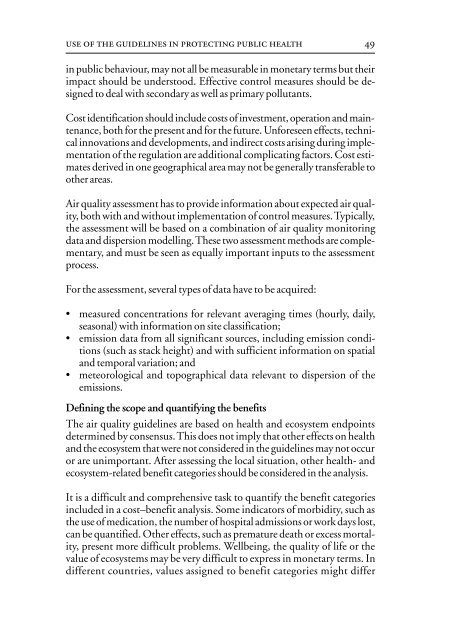Air Quality Guidelines - World Health Organization Regional Office ...
Air Quality Guidelines - World Health Organization Regional Office ...
Air Quality Guidelines - World Health Organization Regional Office ...
You also want an ePaper? Increase the reach of your titles
YUMPU automatically turns print PDFs into web optimized ePapers that Google loves.
use of the guidelines in protecting public health<br />
in public behaviour, may not all be measurable in monetary terms but their<br />
impact should be understood. Effective control measures should be designed<br />
to deal with secondary as well as primary pollutants.<br />
Cost identification should include costs of investment, operation and maintenance,<br />
both for the present and for the future. Unforeseen effects, technical<br />
innovations and developments, and indirect costs arising during implementation<br />
of the regulation are additional complicating factors. Cost estimates<br />
derived in one geographical area may not be generally transferable to<br />
other areas.<br />
<strong>Air</strong> quality assessment has to provide information about expected air quality,<br />
both with and without implementation of control measures. Typically,<br />
the assessment will be based on a combination of air quality monitoring<br />
data and dispersion modelling. These two assessment methods are complementary,<br />
and must be seen as equally important inputs to the assessment<br />
process.<br />
For the assessment, several types of data have to be acquired:<br />
• measured concentrations for relevant averaging times (hourly, daily,<br />
seasonal) with information on site classification;<br />
• emission data from all significant sources, including emission conditions<br />
(such as stack height) and with sufficient information on spatial<br />
and temporal variation; and<br />
• meteorological and topographical data relevant to dispersion of the<br />
emissions.<br />
Defining the scope and quantifying the benefits<br />
The air quality guidelines are based on health and ecosystem endpoints<br />
determined by consensus. This does not imply that other effects on health<br />
and the ecosystem that were not considered in the guidelines may not occur<br />
or are unimportant. After assessing the local situation, other health- and<br />
ecosystem-related benefit categories should be considered in the analysis.<br />
It is a difficult and comprehensive task to quantify the benefit categories<br />
included in a cost–benefit analysis. Some indicators of morbidity, such as<br />
the use of medication, the number of hospital admissions or work days lost,<br />
can be quantified. Other effects, such as premature death or excess mortality,<br />
present more difficult problems. Wellbeing, the quality of life or the<br />
value of ecosystems may be very difficult to express in monetary terms. In<br />
different countries, values assigned to benefit categories might differ<br />
49

















